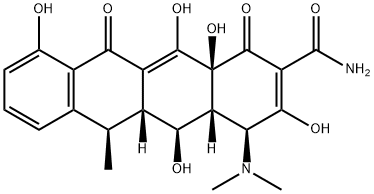CHEMICAL AND PHYSICAL PROPERTIES
| Color/Form | YELLOW, CRYSTALLINE POWDER |
|---|---|
| Melting Point | 201 °C |
| Solubility | 50 mg/mL |
| LogP | 0.63 |
| Dissociation Constants | 3.09 |
| Collision Cross Section | 197.4 Ų [M+H]+ [CCS Type: TW] |
| Other Experimental Properties | CHARS WITHOUT MELTING @ ABOUT 201 °C. /DOXYCYCLINE HYDROCHLORIDE/ |
COMPUTED DESCRIPTORS
| Molecular Weight | 444.4 g/mol |
|---|---|
| XLogP3 | -0.7 |
| Hydrogen Bond Donor Count | 6 |
| Hydrogen Bond Acceptor Count | 9 |
| Rotatable Bond Count | 2 |
| Exact Mass | 444.15326573 g/mol |
| Monoisotopic Mass | 444.15326573 g/mol |
| Topological Polar Surface Area | 182 Ų |
| Heavy Atom Count | 32 |
| Formal Charge | 0 |
| Complexity | 956 |
| Isotope Atom Count | 0 |
| Defined Atom Stereocenter Count | 6 |
| Undefined Atom Stereocenter Count | 0 |
| Defined Bond Stereocenter Count | 0 |
| Undefined Bond Stereocenter Count | 0 |
| Covalently-Bonded Unit Count | 1 |
| Compound Is Canonicalized | Yes |
PRODUCT INTRODUCTION
description
Doxycycline is tetracycline in which the 5beta-hydrogen is replaced by a hydroxy group, while the 6alpha-hydroxy group is replaced by hydrogen. A semi-synthetic tetracycline antibiotic, it is used to inhibit bacterial protein synthesis and treat non-gonococcal urethritis and cervicitis, exacerbations of bronchitis in patients with chronic obstructive pulmonary disease (COPD), and adult periodontitis. It has a role as an antibacterial drug, an antimalarial, a geroprotector, an anti-inflammatory agent and an immunomodulator.

